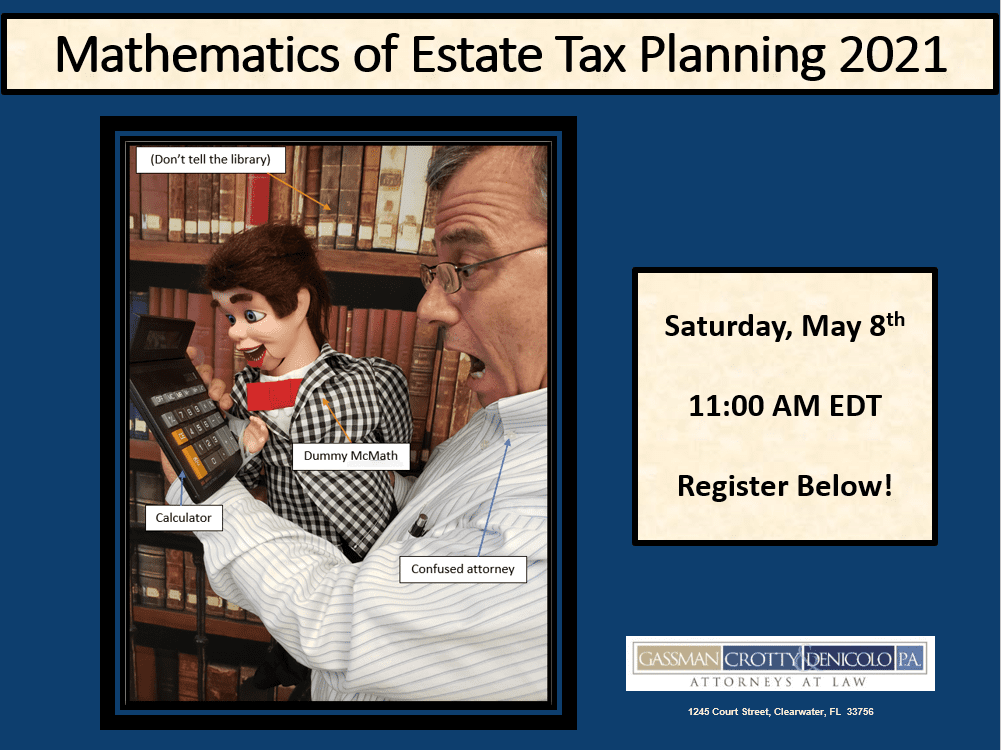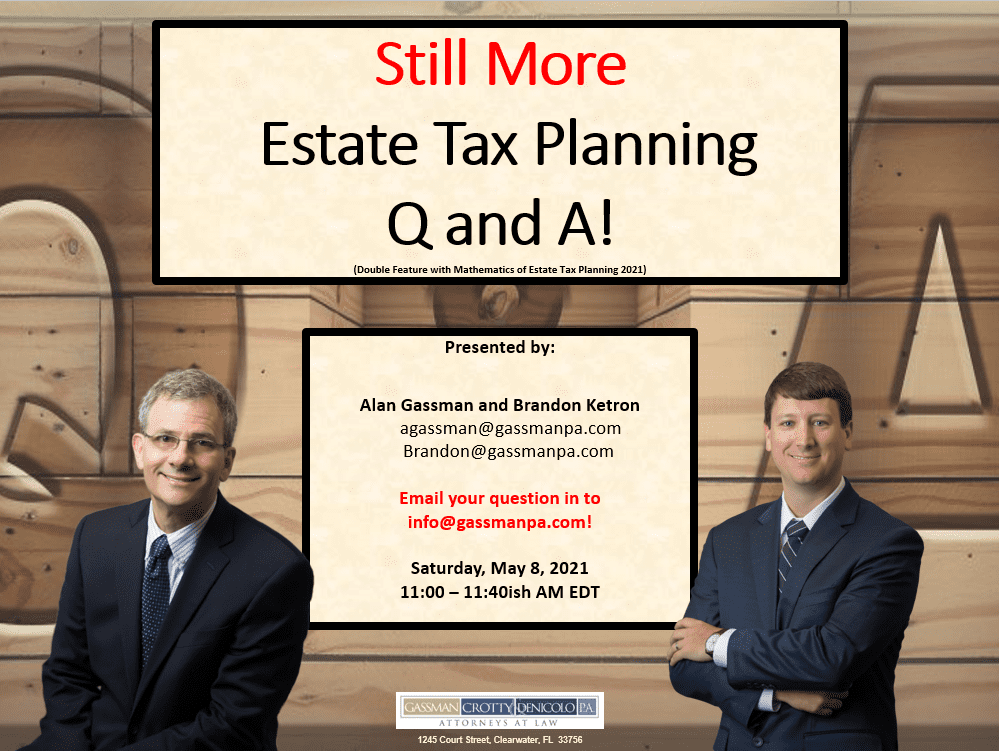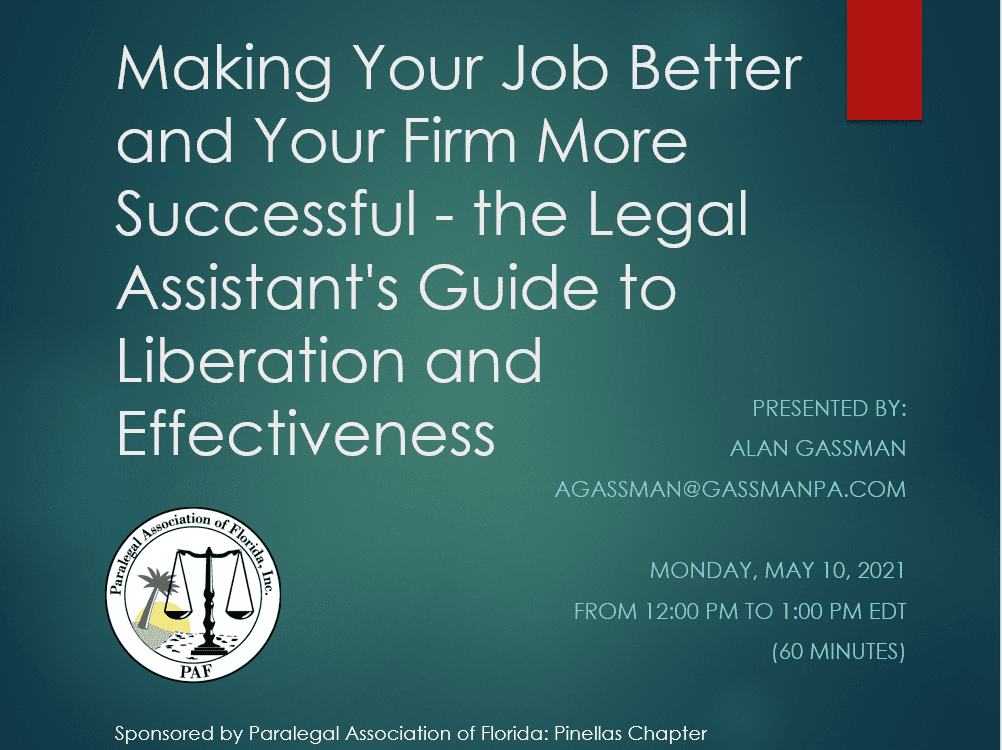The Thursday Report – Issue 304
|
ALWAYS FREE, SOMETIMES PUBLISHED ON THURSDAYS Making Thursday a Better Day for Most of Humanity Friday, May 7th, 2021 – Issue 304 Having trouble viewing this? Use this link
|
Table of Contents
Article 1Get your SLAT – That’s Where It’s At (Part 2)Part 1 is in last week’s Thursday Report HEREArticle 2A Florida Fraudulant Transfer Decision – Not Ready for Prime Time Draft (Part 2)Part 1 is in last week’s Thursday Report HEREArticle 3Insurance Briefing: $0 Cash Value, but $941,803 Gift Value? Say WHAT????Article 4The 501(c)(6) Noncompliance Problem – How Many Industry and Professional Organizations Are Out of Compliance and Should Not Have Qualified for PPP LoansFeatured EventsAll Upcoming EventsForbes CornerFor Finkel’s FollowersHumorReviews
|
Article 1Get your SLAT – That’s Where It’s At(Part 2)
By: Alan Gassman and Christopher DenicoloFind Part 1 in last week’s Thursday Report HERE The authors recently prepared such a letter to a sophisticated retired CPA client that was largely similar to the following, although without the authors’ annotations in the footnotes, which provide considerations regarding the design of a SLAT to reader of this article: Dear Client: It was a pleasure to speak with you on Friday. I thought that it would be useful to reiterate much of what we discussed. Under the federal estate and gift tax system, there is presently an $11,700,000 unified estate and gift tax exemption. Under this exemption, a person can make large gifts which reduce the exemption amount for both estate and gift tax purposes. In addition, the first $15,000 of gifts per year given directly to any one person do not count against the exemption. For example, if you gave your brother-in-law and his wife $30,000 in a given year, this would not count against your exemption. If you gave them $1,030,000 in a particular year, then your exemption would go down from $11,700,000 to $10,700,000. Under the Bernie Sanders proposed Estate and Gift Tax Reform Bill, the gift tax exemption would come down to $1,000,000. If you make a taxable gift of $120,000 this year that does not qualify for the $15,000, then your lifetime exemption would be $880,000 after the Bernie Sanders Bill passes (if it passes). Therefore, if you thereafter gift over the $15,000 per person per year amount, then the reduction would be from $880,000, and the gift tax of at least 40% (and possibly up to 65%) would be owed to the extent that you give in excess of the $880,000 during your lifetime. In addition, the Bernie Sanders Bill would reduce the federal estate tax exemption to $3,500,000 per person, so your exemption would be $3,380,000 if the reduction occurs before or after you make a $120,000 reportable gift. Even though it seems to me that it is unlikely that these provisions of the Bernie Sanders Bill could pass, many clients are advancing their estate tax planning under the assumption that something will happen eventually. For example, the estate tax exemption is scheduled to come down to half of its otherwise inflation-adjusted amount in 2026 (which is expected to be approximately $6,250,000), and Congress could be in gridlock from now until well after 2026 on this issue. Alternatively, a Democratic sweep of the House and Senate in 2022 could yield drastic changes to the federal estate and gift tax law, similar to what has been proposed by Bernie Sanders. As a result, many married clients are entering into an estate planning trust arrangement known as a “Spousal Lifetime Access Trust” (a “SLAT”) where one spouse forms an irrevocable trust for the benefit of the other spouse and their descendants. A combination of estate tax planning techniques that can be very effective for most individuals in your situation involves the creation of a SLAT for your spouse and descendants, and also a strategy called the “Installment Sale to a Defective Grantor Trust” and involves the following principles: 1. You can establish one or more irrevocable trusts for the benefit of your spouse and descendants that will pass estate tax-free but would be disregarded for income tax purposes.
2. As a result of this, you can pay the income tax on the income of the trust, without such payments being considered to be gifts for gift tax measurement purposes. This means that your exemptions would not be reduced and no gift tax would result from payments of income tax on the trust.
3. In addition, you can exchange or sell assets to the trust in exchange for other assets or a long-term low-interest note income tax-free, without this being considered to be a gift. Further, the interest on the note (which can be at a low rate) will not be considered as income to you for income tax purposes as long as the trust is disregarded for income tax purposes.
4. In addition, if you are selling or transferring minority or non-voting ownership interests in an LLC or other entity, then a discount may be taken in determining the value of what is sold or transferred. For example, if an LLC has $1,000,000 in underlying assets, and you transfer a 70% non-voting interest to the trust, then the value of the 70% non-voting LLC interest is probably worth something like $490,000 after accounting for a 30% valuation discount. Please keep in mind that the Bernie Sanders Bill would grandfather arrangements put into place using the above four advantages before the Bill passes, but would essentially take away the right to use these four features in the future, or to make substantial changes to arrangements in place on the day that the Bill passes. An example of an appropriate SLAT arrangement might be as follows: Howard has $1,500,000 worth of investments in an LLC that he has owned for three or four years. He would like to have the investments available to benefit his wife, Wilma, for her lifetime, and then to pass to be held for the lifetime benefit of their children, and later their grandchildren, without being subject to federal estate tax. Howard forms an irrevocable SLAT for Wilma and the children, and names Wilma and their friend, Frieda, as the co-trustees. Howard will have the right to replace the trustee of the trust at any time and for any reason with an individual who is not related to Howard or employed by him. The trust provides that Wilma can make distributions to herself based upon what is reasonably needed for her health, education, maintenance, and support. Frieda, as an independent trustee who is not a beneficiary of the trust, will have the power to distribute to Wilma any or all of the Trust assets at any time and for any reason as Frieda determines in her sole and absolute discretion, with no duty whatsoever to make any such distribution. The Trust also gives Wilma the right to redirect how the trust assets will pass upon her death as long as they are used solely for their descendants. This is known as a “limited power of appointment.” In the example, Howard retains the right to replace trust assets with assets of equal value, which makes the trust “disregarded” during Howard’s lifetime for federal income tax purposes. Additionally, Wilma’s status as the trustee of the trust and as a beneficiary of the trust also causes the trust to be “disregarded” for federal income tax purposes during Howard’s lifetime. This results in all income and deductions of the trust being reported on the income tax return of the Grantor, or the joint income tax return of the Grantor and the beneficiary/spouse, if the spouses file a joint Form 1040 income tax return. The trustee of the SLAT should file a blank Form 1041 for the trust with the Internal Revenue Service (IRS), along with a statement indicating that the trust has been established and that all income and deductions will be reported on Howard’s tax returns. It is also prudent to include a list of the income and deductions of the trust on the statement. Additionally, the trust provides for Howard and Wilma’s trusted accountant, Alex, and Howard’s cousin, Charles, to serve as independent “Trust Protectors” who can amend the trust (but only with Wilma’s consent, or the consent of Howard and Wilma’s common adult children) under certain circumstances, such as to modify the trusteeship or change the distribution standards applicable to the trust. Howard makes a gift of $100,000 to the trust and provides that his four children each have the right to withdraw up to $15,000 from the trust within 60 days of when he makes the contribution. This will cause $60,000 of the contribution not to count against Howard’s $11,700,000 estate and gift tax exemption if he makes no other gifts to the children during the year. Howard also provides Wilma with a right to withdraw up to $5,000 from the trust within 60 days of his contribution. This allows for another $5,000 of the $100,000 contribution to not be considered to be a gift that will reduce Howard’s lifetime exclusion. None of Wilma or the children exercise their withdrawal rights. Howard will, therefore, file a gift tax return in the following calendar year showing use of only $35,000 of his $11,700,000 estate tax exemption, so it will be $11,650,000, or will go to $965,000 if the Bernie Sanders Bill passes. Howard recapitalizes the ownership of his LLC so that he owns 1% of the LLC as the sole voting member and 99% as a non-voting member. Howard then sells his 99% non-voting member interest to Wilma and Frieda, as co-trustees of the trust, in exchange for a long-term low-interest promissory note. If this occurs in May of 2021, then Howard and Wilma can use the lowest interest rate that applies under the “Applicable Federal Rates” that are issued by the IRS for March, April, and May of 2021. Howard’s life expectancy is 20 years, so his lawyer recommends a 20-year promissory note so that if interest rates go up, the note will be locked into the low rate now available for 20 years, which requires a minimum interest rate of 1.61% per year based upon the March 2021 Applicable Federal Rate for “long-term” debt obligations (i.e., loans with a term of longer than 9 years). Howard hires a valuation expert recommended by his certified public accountant who reviews the information about the LLC and its investments, and the valuation expert determines that a 30% valuation discount should apply to the value of a non-voting interest in the LLC. Therefore, the promissory note will be for just under $1,039,500, and the annual interest payable will be approximately $16,735 per year based upon an annual interest rate of 1.61%. The trustee will also be able to prepay the note without penalty. One variation to the above is for the promissory note to be “self-canceling”, at least to some extent. This variation requires that the higher interest rate be used on the promissory note in exchange for the promissory note “canceling” if the Grantor (i.e., Howard) dies during the promissory note term. The benefit of this technique is that the value of the note will not be included in Howard’s estate if he were to die during the note term. The downside is that a higher interest rate must be used, which would require additional amounts of payments to be made annually and which would therefore increase Howard’s gross estate for federal estate tax purposes. The additional interest rate charged under a self-canceling installment note (“SCIN”) is known as a “risk premium” and generally is based upon the actuarial life expectancy if the Grantor/spouse is of reasonable health when the note is entered into. It is usually appropriate that the Grantor/spouse has at least a 50% chance of living to his or her actuarial life expectancy. Normally, the note will need to balloon based upon the life expectancy of the person when it is entered into. For example, a 60-year-old has a life expectancy of 21.54 years under the current actuarial tables, and said actuarial tables provide that the applicable annual interest rate for a 21-year SCIN that would cancel if the Grantor died during the 21-year term should be 3.578%. Therefore, if the 60-year-old dies before the end of the 21-year promissory note term, then the promissory note should not be considered as a taxable asset for federal estate tax purposes. For a 50-year-old, the life expectancy under the actuarial tables is 29.88 years, and the interest rate for a 29-year interest only SCIN would be 2.63%. For many younger clients, it therefore makes sense to use a SCIN rather than a conventional promissory note because the risk premium is low given the relatively small likelihood that the person would die during his or her actuarial life expectancy. There are several guidelines that must be followed with respect to the creation and operation of the SLAT, in order to help assure that the trust functions as intended and that unintended adverse estate or gift tax consequences do not result. These guidelines are as follows: 1. The trust must be funded solely by the grantor/spouse, and not by the beneficiary/spouse. If the spouse who is the beneficiary of the trust is shown to have made contributions to it and is a beneficiary of assets so contributed, then that portion of the trust that has been contributed by the beneficiary’s spouse will be considered to be owned by the beneficiary/spouse upon his or her death. This can have adverse tax and creditor protection consequences because the portion of the trust that is considered to be owned by the beneficiary/spouse will be subject to estate tax upon his or her death, and also will be subject to any creditor claims against the beneficiary/spouse. For this reason, we normally have the grantor/spouse as the sole seller and contributor of assets to the trust because if the IRS were to determine that a sale to the trust by the beneficiary/spouse was a “bargain sale/part gift,” then the gift element would be considered to be a contribution in part by the beneficiary/spouse, causing the assets to be subject to estate tax to that extent. As a protective measure, we have a provision in our trusts which provides that any contribution considered as having been made by the beneficiary’s spouse will go into a separate subtrust to benefit only descendants. Nevertheless, the IRS may not respect such a “safety clause,” especially if the addition to the trust’s net value by the beneficiary spouse is intended, or the result of highly aggressive conduct. For example, if the grantor/spouse makes an $800,000 gift to the trust and the beneficiary/spouse sells an asset to the trust for $1,100,000 (that is later determined to be worth $1,300,000) in exchange for a $1,100,000 note, then the beneficiary/spouse may be considered to be the owner of 20% of the trust assets for estate tax purposes. The provision in our Trust Agreements should cause 20% of trust assets to be considered as held in a separate subtrust for the sole benefit of the descendants of the spouses and not for the benefit of the beneficiary/spouse. It is noteworthy that when a trust is considered to be created by one spouse for income tax purposes (for example, because that spouse funded the trust with a gift and retained the right to replace trust assets with assets of equal value), then monies owed by the trust to the other spouse will cause interest income to the other spouse and may cause an interest deduction to the grantor/spouse depending on the circumstances (such as whether the spouses itemize their deductions, and if the interest relates to a personal residence or business or investment assets). 2. One potential issue is where assets contemplated for transfer are owned jointly or in part by the beneficiary/spouse. As described above, it is important that the beneficiary/spouse not be considered as a contributor to the trust because of the adverse estate tax and creditor protection consequences that could result. When the beneficiary/spouse has an ownership interest in assets that the couple would like to have go into the SLAT, the grantor/spouse may purchase those assets from the beneficiary/spouse by trading assets of equal value or giving the beneficiary/spouse a bona fide promissory note that is enforceable under state law. For example, Howard and Wilma would like for Howard to donate $100,000 to a trust for Wilma and descendants and sell an investment property that Howard and Wilma own jointly that is worth $400,000 to the trust. Howard may give Wilma $200,000 from his checking account in exchange for Wilma transferring her 50% ownership in the property to Howard. Howard may then sell the property to the SLAT in exchange for a note. As described above, if Wilma makes a sale or loans money to a trust considered as owned by Howard for income tax purposes, then Wilma will have taxable income that must be reported on her Form 1040 Income Tax Return or the return that she and Howard file jointly, and Howard may or may not have a corresponding deduction, depending on the circumstances (such as whether Howard and Wilma itemized their deductions, and if the interest relates to a personal residence or business or investment assets). 3. It is important to have a valuation report prepared by a qualified and reputable valuation expert to support the sale price of the asset being sold. This can help assure that the sale price is based upon the fair market value of the asset being sold and that such sale price might withstand IRS scrutiny. Nevertheless, the IRS may challenge the sale price and argue that the transaction was a “bargain sale” whereby the excess in the value of the asset over the sale price is considered to have been a gift made by the grantor/spouse. One way to reduce the risk of a bargain sale characterization by the IRS would be to have the grantor/spouse who is selling the asset do so with “valuation adjustment clauses,” which would cause a change in the sale amount if it turns out that the value of the assets transferred is more than the note received in exchange for it. It is very important that precise language be used under these types of clauses which specifically refers to if and when a court would make a determination of a value other than what is used in a gift or sale transaction for federal gift tax purposes. A recent court case reached an unintended result when interpreting a valuation adjustment clause because the language did not contain the necessary wording. There are two different kinds of valuation adjustment clauses: A. A commonly used valuation adjustment clause is a “Wandry” clause, which is named after a recent court case in which a court upheld use of this type of provision. The Wandry valuation adjustment clause involves stating the assets being transferred in terms of a specified dollar amount, rather than in terms of a percentage of ownership in an entity. The goal is that the percentage of ownership of an entity or asset transferred will be reduced if the IRS takes the taxpayer to court and proves that the interest was worth more than agreed. An example of the language used in this type of clause is as follows: “I hereby give to the Trustee of ABC Trust an amount of non-voting ownership interests in ABC, LLC worth $1,000,000 in exchange for a $1,000,000 promissory note.” We typically would have a valuation report showing that $1,000,000 of non-voting LLC interests are equivalent to a specified percentage of ownership in the LLC (such as 65%). The result of the above language is that, if it turns out that 65% of ABC, LLC is worth more than $1,000,000, then the percentage given will be reduced to whatever is worth $1,000,000. B. A second type of valuation adjustment clause is known as a “King” clause, which also is named after a court case that approved this type of provision. The King clause defines the assets transferred in terms of a percentage of ownership as is typically done under a conventional assignment document, but provides for the sale price and/or outstanding balance of the promissory note to be adjusted based upon whether the value of the assets transferred is determined to be greater than what is contemplated under the documents. An example of the language used in a King valuation adjustment cause is as follows: “I accept a $1,000,000 promissory note for 65% of ABC, LLC, but if it turns out that 65% of ABC, LLC is worth more than $1,000,000, then the promissory note, with retroactive interest, will be for the appropriate greater amount.” 4. From an operational standpoint, the SLAT should be kept separate and apart from the assets of the couple, and have its own separate checking or brokerage account, and be considered a separate fiscal entity. The SLAT does not need to file an income tax return or pay any income tax, but it is best for the SLAT to have a separate taxpayer identification number to help establish that it is a separate entity, and to facilitate it having its own bank or brokerage account. The SLAT does need to file a blank Form 1040 income tax return with a statement that basically lets the IRS know that the income and deductions of the SLAT are going onto the tax return of the donor, or the married couple if they file jointly. As mentioned above, there is no income tax on the sale of assets to a trust that is disregarded for income tax purposes, and no interest considered to be received or paid for income tax purposes when the trust owes money and pays interest to the Grantor. It is important that the interest payments be made at least annually and that the terms of the documents are complied with to help assure that the trust and the installment sale will be respected by the IRS. 5. A common question asked by clients is whether spouses can establish trusts for each other and descendants. There is something known as the “reciprocal trust doctrine” where the IRS has argued that each spouse would be considered as a beneficiary of the trust that they have established, which could lead to the assets in both trusts being included in the estate of the applicable Grantor and subject to the creditor claims of the Grantor spouse. There are two tax court cases and a few IRS rulings which have permitted “reciprocal SLATs,” but our law firm does not recommend them or feel comfortable installing these in the way that some estate planners might. Our concern is that the tax court and IRS pronouncements do not mention the creditor protection implications of reciprocal trusts. Specifically, if under state law, a creditor can reach into a reciprocal trust that spouses establish for each other (which would be based upon a “state law reciprocal trust doctrine”), then the IRS likely would take the position that the assets in each trust are therefore subject to estate tax in the applicable Grantor’s state. There is a “common law” reciprocal trust doctrine that goes back to England, which provides that if two people form trusts for each other at approximately the same time and the trusts benefit each other, then creditors of each person may reach into the trust established for them by their spouse as if they had established the trust for themselves. Florida, like many other states, has adopted the common law of England as it existed on July 4, 1776. Therefore, our concern is that the trust would be subject to estate tax if creditors can reach into the trust as a matter of state law. For this reason, clients who would like to consider “reciprocal trusts” should establish one or both trusts in an asset protection jurisdiction that does not allow creditors into a trust even if it is formed and funded by a beneficiary, such as Nevada, South Dakota, Alaska, and Delaware. Nevertheless, individuals residing in non-asset protection jurisdictions, such as Florida, Texas, and California, cannot be sure that the law of an asset protection jurisdiction where a trust is formed would be applicable if the debtor/grantor of the trust, the beneficiary, and the creditor are all in a state like Florida, Texas or California that does not recognize the asset protection trust laws. Therefore, the vast majority of our clients form one trust as a SLAT, with the beneficiary spouse forming a trust solely for descendants that may be situated in Nevada, South Dakota, Alaska, or Delaware but may allow one or both spouses to become beneficiaries only if unexpected circumstances arise, and individuals named as Trust Protectors have the discretion to add one or both spouses as a beneficiary if and when such unexpected circumstances may arise. Nevertheless, it may be of interest that trusts that provide only for the health, education, maintenance and support of one or more beneficiaries may be moved to Nevada, South Dakota, Delaware or another asset protection jurisdiction in order to provide for independent Trust Protectors to have the ability to add the grantor/spouse as a beneficiary of the trust if and when certain circumstances occur. This approach can add additional flexibility, while likely avoiding any adverse estate tax or creditor issues based upon the laws of the above-referenced jurisdictions providing that the creditors of a grantor of an Irrevocable trust cannot reach into a trust established for the Grantor’s benefit. Unexpected circumstances may include divorce and significant financial misfortune (such as the Grantor’s net worth dropping below a certain threshold which is far lower than the Grantor’s net worth as of creation of the trust). As a practical matter, most couples who have estate tax issues should be able to live comfortably on the assets not going into the SLAT, promissory notes that the SLAT may owe the Grantor/spouse, and promissory notes that may be due from an irrevocable trust established solely from descendants (a “Descendants’ Trust), without ever having to worry about whether they might need to invade a Descendants’ Trust. As a worst-case scenario, the Descendants’ Trust might make distributions to descendants who might then loan money or provide financial assistance for parents, although there cannot be an agreement or understanding that this would ever occur when a Descendants’ Trust is formed and funded. Please do not hesitate to contact us if you have any questions or if you would like to discuss this further. We appreciate the opportunity to be of service. As described above, the SLAT is a versatile and flexible planning tool that can be a great fit for many clients’ situations. The SLAT can provide both advantages and be subject to limitations or potential issues. It is therefore important to assure that the clients are aware of potential restrictions and implications of establishing and funding a SLAT and to program in as much flexibility as possible. One question is if the beneficiary/spouse is considered to have made a gift by not withdrawing amounts as needed for health, education, maintenance, or support when he or she has the right to do so. This is a possible issue, although, to the authors’ knowledge, it has not been argued successfully by the IRS. Nevertheless, the adverse effects of the spouse being considered as having made a gift to the Trust could be catastrophic because if the spouse makes a contribution to the Trust that benefits him or her, then the value of the Trust attributable to such gifts will be subject to estate tax upon his or her death and may be subject to his or her creditor claims. It should be possible for the beneficiary/spouse to choose an independent trustee who can give the spouse unlimited amounts based upon the HEMS standard, but might be best to limit the scope of potential Trustees that the beneficiary/spouse can appoint to any one or more listed individuals or trust companies. In any event, it is advisable that no such independent trustee should be a relative or employee of the Grantor or the Grantor’s spouse, and that there be no pre-existing understanding that the independent trustee would give the beneficiary/spouse “whatever he or she wants.” By the same token, it is common not to have an independent trustee who could give the assets of the Trust to the beneficiary/spouse in case some undue influence on both the beneficiary/spouse and the independent trustee were to apply. Notwithstanding the above, it is common to have Trust Protectors appointed to be able to amend a Trust, and they may be given the power to direct the assets to the spouse. It is important to assure that the power of appointment be structured as a “limited” or “special” power of appointment, and not as a general power of appointment. A limited or special power of appointment is a power of appointment which is exercisable in any manner other than in favor of: (1) the powerholder herself; (2) the powerholder’s creditors; (3) the powerholder’s estate; or (4) the creditors of the powerholder’s estate. If a power of appointment allows the powerholder to exercise the power in favor of any one or more of the four above potential appointees, then the power will be considered as a general power of appointment, and the assets subject to the power will be included in the powerholder’s gross estate for federal estate tax purposes and probably would be subject to the powerholder’s creditors under estate law. Another consideration is whether the exercise of the limited power of appointment should be exercisable solely with the consent of one or more parties so as to prevent unwise or improper exercise. This approach is less common, as typically the class of appointees would be restricted so as to limit the possibility of undue influence or improper exercise of the power of appointment. An exception to grantor trust status applies if any and all distributions to the beneficiary/spouse must be approved by an “adverse party” and the spouse is not a trustee of the Trust. If the beneficiary/spouse is the Trustee and beneficiary of a SLAT, then it generally will be considered to be a grantor trust owned by the grantor for income tax purposes until the spouse resigns from being the Trustee. In that event, the Trust may not be considered as owned by the grantor for income tax purposes unless the grantor obtains another “grantor trust power” over the Trust, such as the right to replace trust assets with assets of equal value. For this reason, most well-drafted SLATs provide that no distributions will be made to the beneficiary/spouse without the approval of at least one other beneficiary of the Trust. Families having several children and grandchildren typically have no problem with this standard because if no child or grandchild will approve a distribution, they can simply be disinherited under the exercise of the beneficiary/spouse ‘s power of appointment. This is a good reason to let the spouse’s power of appointment be exercisable to charity in case there is family squabbles or the spouses wish to disinherit members of the family for actions taken after the grantor/spouse’s death. Another common power is to give the Trust Protector the power to give the surviving spouse the right to direct Trust assets to creditors of his or her estate, which should be a general power of appointment. This approach might be attractive where the estate tax is not as much as a consideration as the income tax because giving the beneficiary/spouse a general power of appointment will cause the assets to be considered as owned by him or her for federal estate and income tax purposes to allow for the assets of the Trust to receive a new income tax basis equal to fair market value upon her death. Trust Protectors may also be given the power to have other older relatives have a similar power to get a new income tax basis on the death of a powerholder. Under the present law, it does not appear that the powerholder needs to be a beneficiary of the Trust in order to cause this to happen. This result seems too good to be true and may, therefore, be eliminated in future tax law changes. It might be possible for the grantor/spouse and beneficiary/spouse to split the gift made to the SLAT under the “gift-splitting rule” notwithstanding that the beneficiary/spouse is a beneficiary of the trust. The effect of the split gift is that the gift is treated as having been made one-half by each spouse for federal estate and gift tax purposes, therefore reducing each spouse’s exclusion amount by one-half of the value of the gift. The IRS takes the position that a spouse cannot split a gift to a trust that he or she is a beneficiary of, but the courts have limited this to situations where it is reasonably expected that the spouse will benefit from the trust, or that the amount that can be split will be reduced by whatever portion of the trust that would be expected to benefit the spouse. If Mr. and Mrs. Smith have $100,000,000 in joint assets, and the trust provides that Mrs. Smith can only access the trust if and when needed for health, education, and maintenance after taking into account other sources of income and resources, then it appears the gift can be split. If this is an issue and the trust indicates that Mrs. Smith’s cumulative benefits from the trust cannot exceed $4,000,000, then she should be able to split the gift to the extent of at least $5,000,000 ($9,000,000 minus $4,000,000) in the above example. The vast majority of SLATs are prepared and implemented by individuals who reside in States that would allow creditors to reach into a trust where the Grantor is a beneficiary. This follows the English common law and was the law of all 50 states until the 1990s when Alaska passed a trust law which basically provides that a grantor’s creditors cannot reach into an Irrevocable trust where the Trustee has the discretion to make distributions to the grantor. As the result of this, it appears that a SLAT formed by a family who resides in an APT Trust jurisdiction may provide that the Grantor will be a beneficiary of the trust, although the IRS has not heartily endorsed this. Therefore, individuals who reside in APT jurisdictions may want to provide that Trust Protectors can add the Grantor to the trust at their discretion so that the Grantor is not considered to be a beneficiary of the trust. This assumes that the Trust Protectors are not “fiduciaries” and have full discretion as to whether to add the Grantor or not. Families residing outside of Asset Protection Trust jurisdictions need to be even more careful because we do not yet have many court cases on the question of whether the law of a non-APT jurisdiction will apply to a trust where the Grantor, beneficiaries, and creditors involved in the situation are in a state that does not recognize the APT rules. As an additional safeguard, we recommend that grantor cannot be added by as a beneficiary by the Trust Protectors unless an unexpected “event of independent significance” occurs, such as in the event of a divorce or if the Grantor’s assets and earnings become insufficient to support him, or his net worth drops below a certain level. In addition, such trust agreements should specifically provide that the Grantor is not a beneficiary that could be made to be a discretionary beneficiary in Nevada or South Dakota. A Private Letter Ruling issued by the IRS in 2009 (PLR200944002) held that an irrevocable trust established by a grantor which he is the beneficiary would not be subject to estate tax in the grantor’s estate if the grantor’s creditors cannot reach into the Trust under state law, so long as the grantor is not the trustee and there is not an understanding or pre-existing arrangement between the grantor and trustee that trustee’s exercise his discretion to make distributions to or for the benefit of the grantor.
|
||||||||||||||||||||||||||||||||||||||||||||||||||||
Article 2A Florida Fraudulant Transfer Decision – Not Ready for Prime Time Draft(Part 2) |
||||||||||||||||||||||||||||||||||||||||||||||||||||
Article 3Insurance Briefing: $0 Cash Value, but $941,803 Gift Value? Say WHAT????
By David HowellDavid W. Howell, CLU®, ChFC® In over 30 years of serving attorneys, accountants, family office managers, trust officers and others professionals in the wealth transfer process, David has developed expertise in working with affluent clients that enables him to deliver life insurance portfolios designed and priced to support the financial and estate plans created by the advisors.
|
||||||||||||||||||||||||||||||||||||||||||||||||||||
Article 4The 501(c)(6) Noncompliance Problem – How Many Industry and Professional Organizations Are Out of Compliance and Should Not Have Qualified for PPP Loans
By: Alan Gassman and Wesley Dickson Section 501(c)(6)1 allows for tax exemptions for non-profit organizations such as business leagues and the chambers of commerce. An organization filing under this exemption must be devoted to improving business conditions of one or more lines of business and not perform services for the benefit of individual persons. However, some organizations have been operating under the guise of a §501(c)(6) entity, while providing services for their members that, by our review, should disqualify them from exemption. To further illustrate this point, the following example shall be employed… Continue reading. Click HERE to subscribe to Bloomberg Tax for future content.
|
||||||||||||||||||||||||||||||||||||||||||||||||||||
Featured Events1. DOUBLE FEATUREMathematics of Estate Tax Planning 2021 & Still More Q and A on Estate Tax PlanningRegister Here |
||||||||||||||||||||||||||||||||||||||||||||||||||||
All Upcoming EventsRegister for all future free webinars from Gassman, Denicolo & Ketron, P.A. using this link |
||||||||||||||||||||||||||||||||||||||||||||||||||||
|
Saturday, May 8, 2021 |
Free webinar from our firm |
Alan Gassman presents: Mathematics of Estate Tax Planning 2021 & Still More Questions and Answers on Estate Tax Planning from 11:00 to 11:45 AM EDT |
||||||||||||||||||||||||||||||||||||||||||||||||||
| Monday, May 10, 2021 | Paralegal Association of Florida: Pinellas Chapter |
Alan Gassman presents: Making Your Job Better and Your Firm More Successful – the Legal Assistant’s Guide to Liberation and Effectiveness from 12:00 to 1:00 PM EDT |
||||||||||||||||||||||||||||||||||||||||||||||||||
| Thursday, May 13, 2021 | FICPA-FSU Spring Accounting Conference |
Alan Gassman presents: Fine Tuning and Improving Estate and Asset Ownership Planning For All Categories of Clients from 12:50 to 1:40 PM EDT & The Florida CPA’s Practice Guide to Effective Creditor Protection Planning from 1:50 to 2:40 PM EDT |
||||||||||||||||||||||||||||||||||||||||||||||||||
| Wednesday, May 19, 2021 | Free webinar from our firm |
Alan Gassman and Dr. Luz D. Randolph present: Private Foundations from A to Z. How Private Foundations help Donors help Public Charities and Causes from 12:30 to 1:30 PM EDT |
||||||||||||||||||||||||||||||||||||||||||||||||||
| Thursday, May 20, 2021 | Michigan ICLE Annual Probate & Estate Planning Institute |
Alan Gassman presents: Prebankruptcy and Bankruptcy Avoidance Strategies for Challenging Situations from 11:15 AM to 12 PM CT |
||||||||||||||||||||||||||||||||||||||||||||||||||
| Wednesday, June 16, 2021 | Association of Insolvency and Restructuring Advisors’ Pre-conference Bankruptcy Tax Toolbox |
Alan Gassman and Christopher Denicolo present: Tax Planning for Troubled Companies Involving CODI from 4:05 to 4:50 PM EDT |
||||||||||||||||||||||||||||||||||||||||||||||||||
| Wednesday, June 16, 2021 | Free webinar from our firm |
Alan Gassman, Professor Jerry Hesch, and Dr. Luz D. Randolph present: Life Insurance Planning, including Term Life Insurance for Charitable and Non-Charitable Purposes from 12:30 to 1:30 PM EDT |
||||||||||||||||||||||||||||||||||||||||||||||||||
| Wednesday, July 21, 2021 | Free webinar from our firm |
Alan Gassman, Dr. Luz D. Randolph and Michael Lehmann present: Charitable Planning for the Business Owner from 12:30 to 1:30 PM EDT |
||||||||||||||||||||||||||||||||||||||||||||||||||
|
Thursday, July 26-29, 2021 |
AICPA & CIMA ENGAGE 2021 in Las Vegas, NV |
Jerry August, Alan Gassman and Kevin McGraw present: Ready for a Sale Panel on Business in Distress from 9:30 to 10:45 AM PT |
||||||||||||||||||||||||||||||||||||||||||||||||||
| October, 2021 | Notre Dame Tax and Estate Planning Institute | Topic TBD | Coming Soon | |||||||||||||||||||||||||||||||||||||||||||||||||
| Thursday, November 4, 2021 | Estate Planning Council of Birmingham |
Alan Gassman presents: Hot Topics In Estate Tax And Creditor Protection from 8:00 AM to 10:00 AM CT |
||||||||||||||||||||||||||||||||||||||||||||||||||
| Thursday, November 4, 2021 | Alabama Banker’s Association | Topic TBD | Coming Soon | |||||||||||||||||||||||||||||||||||||||||||||||||
Forbes CornerSenate Estate And Gift Tax Bill Will Reduce Exemption To $3,500,000 And Take Away Many OpportunitiesMar 27, 2021 Senator Bernie Sanders released his proposed estate and gift tax reform legislation on Thursday, March 25, to the displeasure of a great many American families and their advisors. Senators Kirsten Gillibrand, Jack Reed and Chris Van Hollen reportedly co-sponsored this plan… Continue reading on Forbes
Planning To Maximize Your Employee Retention CreditMar 23, 2021 The Employee Retention Credit program was enacted as part of the CARES Act on March 27, 2020, to provide reimbursement of wages for businesses affected by the COVID-19 virus and incentivize employers to maintain a pre-pandemic level… Continue reading on Forbes
|
What your Auto-Reply says about you as a LeaderDavid Finkel
“Hello, I am currently out of the office, returning Friday, the 13th. If you need immediate assistance please contact…” We have all used auto-reply messages or auto-responders at one point or another. And with the majority of us still working from home, I see them more often than I ever did before. In the past, I have touched on the idea that being available 24-7 isn’t a good idea, and I wanted to expand on that idea and look at how leaders use (or don’t use) auto reply messages within their own companies. My company, Maui Mastermind, sends millions of emails a year to current and prospective clients and business owners. Understandably, there is always a certain percentage of bounce-back, unsubs, and undeliverable emails, which we work to minimize. But auto-responders are a different thing entirely. I typically see business owners that fall into one of three categories. Type # 1: You have auto-reply set up, regardless of whether you are in the office or not. These business owners have an auto reply set up that says something along the lines of “We are currently working from home, and will get back to you as soon as possible….” or “ Your email is very important to me and I will reply to your message as quickly as I can.” If you fall into this category, you tend to struggle with control issues and letting go. Your inbox is usually very full, and you are often overwhelmed by the sheer number of emails that you receive on a daily basis. To remedy the situation, you should enlist the help of your assistant and set up a screening system where they go in and archive emails accordingly. Those that require your response or review are left in your inbox to work through. This simple daily exercise will usually cut your emails down by approximately 75%. It’s also important to note, that for most business owners, you don’t want to set the expectation that you will reply or respond to every email that comes your way. Some items should not make it to your to-do list. And others, if they don’t help your business move the needle forward, should be left unanswered. Type # 2: You have auto-reply set up when you go on vacation only. You are a traditionalist and you have been doing it this way for many years now. You take a few weeks of vacation a year, and out of habit you set your autoresponder to let others know that you will be delayed in your response time. You may have an assistant that screens your inbox or you may have over time trained those that you work with most to send you emails only if they need your review or feedback on something. If you fall into this category, I want to encourage you to try to go without an auto-responder the next time you take a vacation or time away from the office. Have your assistant screen your emails while you are gone, and see if anyone notices. If you do find a few items that require your immediate attention, those should be the first things you focus on delegating or cross training on when you return to the office. Type # 3: You never use auto-reply. Whether you are out for a few days, or a few weeks you never turn on your autoresponder. Your team knows that your time is valuable and they only send you emails or items that require your review or feedback. You have an assistant screen your emails, and you have realistic expectations set with your team members and vendors on when and if you will respond to a particular email or situation. You understand that not all emails require a response, and you instead focus on the tasks and items that will help propel your business forward. No matter what type you resonate with, there is always room for improvement. Setting realistic expectations and taking control of your inbox and the amount of emails you receive in a day go a long way to helping you focus on the things that matter most. The end goal is to not have to set your auto-reply because you have a business that works for you, even in your absence.
|
|
Younger Readers may not have heard of Samuel Clemens, who was a Broadway actor in the 1970s and became a popular comedian in the 1980s. Here are some of our favorite Samuel Clemens sayings:
“Age is an issue of mind over matter. If you don’t mind, it doesn’t matter.”
A person who won’t read has no advantage over one who can’t read.
There are basically two types of people. People who accomplish things, and people who claim to have accomplished things. The first group is less crowded.
Go to Heaven for the climate, Hell for the company.
Clothes make the man. Naked people have little or no influence on society.
– Samuel Clemens
|
5 Star Reviews from Readers like You!
David Howell“I should have long ago taken a moment to tell you how much I enjoy your Thursday Reports! Good stuff. Candid. No fluff. Funny.” – David Howell
“I soak up your posts, and appreciate your knowledge & enjoy your humor! If I ever win the lottery, you’ll be the 1st guy I call. My husband will be the second.” – Stacey Miller Stacy wins a free lifetime subscription to the Thursday Report and front row tickets to Samuel Clemen’s next comedy show at Capitol Theatre in Clearwater.
“Just an incredible amount of useful information in this week’s newsletter! It will take some time to digest it all.” – Anonymous
Did you like our Thursday Report? Send your thoughts and comments to info@gassmanpa.com for a chance to be our next featured 5 star review!
|
|
Gassman, Denicolo & Ketron, P.A. 1245 Court Street Clearwater, FL 33756 (727) 442-1200
|















